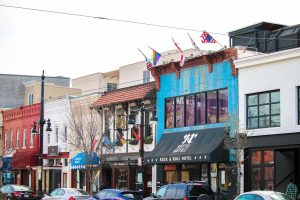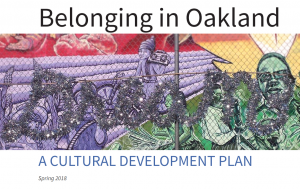This week the Center for Community Progress based in Flint unveils its new data bank of creative placemaking experiments. Known as a pioneer in creating community land banks, the Center considers placemaking, when done equitably, “as one way for communities to leverage creative expression to reshape a community, reverse the systemic silencing of residents, and spur investment.”
Creative placemaking has been a favorite term in the arts and culture community for some time, given its clearest definition possibly in a widely-cited paper by Ann Markusen and Ann Gadwa Nicodemus published in 2010 and institutionalized by the National Endowment for the Arts’ Our Town program and ArtPlace, a collaboration among public and private foundations investing in creative placemaking projects. This story is well told in a new book by Michael Carriere and David Schalliol, The City Creative.
Even earlier, the Project for Public Spaces, inspired by the work especially of William Whyte, was touting the ways intentional design could enrich civic life. A like organization, Reimagining the Civic Commons, states its intention on its website to demonstrate that “transformative public spaces can connect people of all backgrounds, cultivate trust and create more resilient communities.” These organizations embrace a concept I have called “civitas by design,” the belief that the physical environment can enhance and deepen citizenship.
Placemaking, of course, has a long history, even if not so named, going back at least to an earlier era of urban renewal, where whole new sectors of cities, whether downtown or nearby, replaced older, often disinvested communities of color: think Southwest Washington or the Hill neighborhoods in Pittsburgh and New Haven. One could even argue that the New Urbanism movement is yet another manifestation of crafting new places out of old, always with the intention of revitalization, whether chiefly defined in aesthetic or economic terms, or both.
 As popular as “placemaking” has been in the recent period of urban revitalization, it has had a dark side. Sociologist Brandi Thompson Summers details this phenomenon in her 2019 book, Black in Place, on the transformation of H Street Northeast from a modest commercial sector serving the black community in the aftermath of the 1968 riots when capital fled the area to an upscale and hip destination rebranded as the Atlas District. Just edgy enough through the remnants of Black presence to provide a vibe, the area represents a classic example of the gentrification that has overtaken much of Washington in recent years. For further affirmation of the erosive effects of such changes, Summers recounts the contest over cultural practice when white newcomers to the historically Black Shaw neighborhood attempted to shut down Go-go music as it was being broadcast onto the streets. She calls the fight to maintain the practice part of “reclamation aesthetics” a means “through which Black residents navigate spatial inequities and reclaim the paces from which they have been displaced.
As popular as “placemaking” has been in the recent period of urban revitalization, it has had a dark side. Sociologist Brandi Thompson Summers details this phenomenon in her 2019 book, Black in Place, on the transformation of H Street Northeast from a modest commercial sector serving the black community in the aftermath of the 1968 riots when capital fled the area to an upscale and hip destination rebranded as the Atlas District. Just edgy enough through the remnants of Black presence to provide a vibe, the area represents a classic example of the gentrification that has overtaken much of Washington in recent years. For further affirmation of the erosive effects of such changes, Summers recounts the contest over cultural practice when white newcomers to the historically Black Shaw neighborhood attempted to shut down Go-go music as it was being broadcast onto the streets. She calls the fight to maintain the practice part of “reclamation aesthetics” a means “through which Black residents navigate spatial inequities and reclaim the paces from which they have been displaced.
Among those who recognized placemaking as a double-edged sword was Roberto Bedoya, who pointedly described the thin line between placemaking as revitalization and placemaking as gentrification. In another widely-cited essay, Bedoya suggested a subtle shift in language from placemaking to placekeeping.” The blind love of Creative Placemaking that is tied to the allure of speculation culture and its economic thinking of “build it and they will come” is suffocating and unethical, and supports a politics of dis-belonging employed to manufacture a “’place,’” he contends. “Placemaking instead should constitute a series of actions that build special justice, healthy communities, and sites of imaginations.”
When he wrote these words, Bedoya was serving as executive director of the Tucson Arts Council. Subsequently, he was appointed, in 2016, cultural affairs manager for the city of Oakland, where he was tasked with revitalizing the city’s cultural affairs division. Notably the city’s cultural development plan issued in 2018 put equity at the center of its placemaking vision. Asking “whether the city will be “able to avoid the 21st-Century version of the mistakes perpetrated in the last century’s urban renewal,” it commended placemaking as placekeeping: “a significant reorientation of meaning—putting the people who live in a place at the center of the frame as well as their right to make and keep the places where they live.” A notably fast-gentrifying city, Oakland’s commitment to equity extends to the creation of a department of diversity, equity, and inclusion, putting it in a position to put some weight behind the aspirations of its cultural division.
More generally, placemaking has the potential of driving redevelopment at a large scale without much attention at all to what is being displaced in the process. As Susanna Schaller demonstrates in her book on Washington, Business Improvement Districts and the Contradictions of Placemaking, placemaking in the commercial sector can result in significant losses in prevailing culture. And this can happen at a large scale, dwarfing efforts to animate singular spaces such as parks or community institutions. Nearby, in Arlington, Virginia the Washington-based developer JBG Smith is embracing “placemaking” at the heart of the massive redevelopment of the area rebranded as National Landing as the location for Amazon’s new second North American headquarters. What clashes in culture and intent result from such a massive effort remains to be seen, but the company has already been part of the remaking of the historically Black Shaw district in Washington proper.
The projects the Center for Community Progress and Carriere and Schalliol highlight tend to be limited in scale and intent. No doubt they will make a positive impact in their communities, but a larger question remains about placemaking as a practice. As the Oakland cultural development plan asks pointedly, “Can we make room for new businesses and good jobs that can help build a more sustainable economy, strengthen infrastructure, and remedy chronic patterns of degradation, while keeping neighborhoods culturally-recognizable and robust, and retain the best of our diverse values and histories? Will we be able to avoid a 21st-century version of the mistakes perpetrated in the last century’s urban renewal? These are the quandaries of people involved with placemaking— city planners and community developers, socially-conscious architects and builders, and increasingly, collaborations of local government, philanthropy, community-based organizations, and artists.”